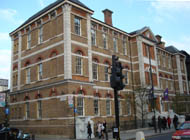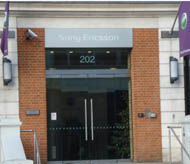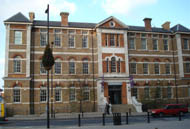West
London Hospital
202 Hammersmith Road, W6 7DG
Medical
dates:
Medical
character:
Acute. Later, geriatric, maternity, rehabilitation, long-stay
The West London Hospital began
in 1856 as the Fulham and Hammersmith General Dispensary, which was
housed in a small 6-roomed building in Queen Street. Increasing
demand led to the leasing of larger premises - Elm Tree House in
Hammersmith Road - in 1860, which became the West of London Hospital
and Dispensary. The Hospital began to admit in-patients, mainly
victims of industrial accidents.
In 1863 it was renamed the West London Hospital.
Elm Tree House was purchased in 1868 and the building was enlarged. New wings were added in 1871, 1883 and 1898.
During WW1 the Hospital was affiliated to the Fourth London General Hospital, with 36 of its beds reserved for sick and wounded servicemen.
On 11th February 1925 Princess Mary opened a new wing, generously financed by Mr Dan Mason. The building contained an accident ward of 16 beds, cancer wards, each of 7 beds, for male and female patients, 26 rooms for private patients and 2 operating theatres. Private patients were charged 5 guineas (£5.25) a week for a single room and 4 guineas (£4.20) for a double room.
In 1937 a new block on the eastern corner of the Hospital was added - the Silver Jubilee Extension - and was officially opened by Queen Mary.
The Hospital ceased to be a District General Hospital in the early 1970s when its accident and emergency department closed, the service moving to the new Charing Cross Hospital in Fulham Palace Road.
Although renowned for its women-centred maternity department from the early 1970s, the Hospital finally closed in 1993 and its services moved to the new Chelsea and Westminster Hospital in Fulham Road.
In 1863 it was renamed the West London Hospital.
Elm Tree House was purchased in 1868 and the building was enlarged. New wings were added in 1871, 1883 and 1898.
During WW1 the Hospital was affiliated to the Fourth London General Hospital, with 36 of its beds reserved for sick and wounded servicemen.
On 11th February 1925 Princess Mary opened a new wing, generously financed by Mr Dan Mason. The building contained an accident ward of 16 beds, cancer wards, each of 7 beds, for male and female patients, 26 rooms for private patients and 2 operating theatres. Private patients were charged 5 guineas (£5.25) a week for a single room and 4 guineas (£4.20) for a double room.
In 1937 a new block on the eastern corner of the Hospital was added - the Silver Jubilee Extension - and was officially opened by Queen Mary.
The Hospital ceased to be a District General Hospital in the early 1970s when its accident and emergency department closed, the service moving to the new Charing Cross Hospital in Fulham Palace Road.
Although renowned for its women-centred maternity department from the early 1970s, the Hospital finally closed in 1993 and its services moved to the new Chelsea and Westminster Hospital in Fulham Road.
Present status (December
2007)
The building was sold and refurbished as self-contained air-conditioned offices (renamed Saunders House). The facade is listed and has been preserved.
The mobile phone makers Sony Ericsson currently rent the building, now called Sony Ericsson House, for £38.50 per sq.ft. The freehold has recently been bought by a Middle Eastern investor.
The building was sold and refurbished as self-contained air-conditioned offices (renamed Saunders House). The facade is listed and has been preserved.
The mobile phone makers Sony Ericsson currently rent the building, now called Sony Ericsson House, for £38.50 per sq.ft. The freehold has recently been bought by a Middle Eastern investor.



The West London Hospital has now become
Sony Ericsson House
(Author unstated) 1917 List of the various hospitals treating military cases in the United Kingdom. London, H.M.S.O.
(Author unstated ) 1925 Hospital world. British Journal of Nursing (February), 30.
Newman C 1966 The history of postgraduate medical education at the West London Hospital. Medical History 10, 339-359.
O'Neill C 1989 (Aug 5) West London Hospital. Nursing Standard 45, 29.
www.chelwest.nhs.uk
www.helical.co.uk
Return to home page